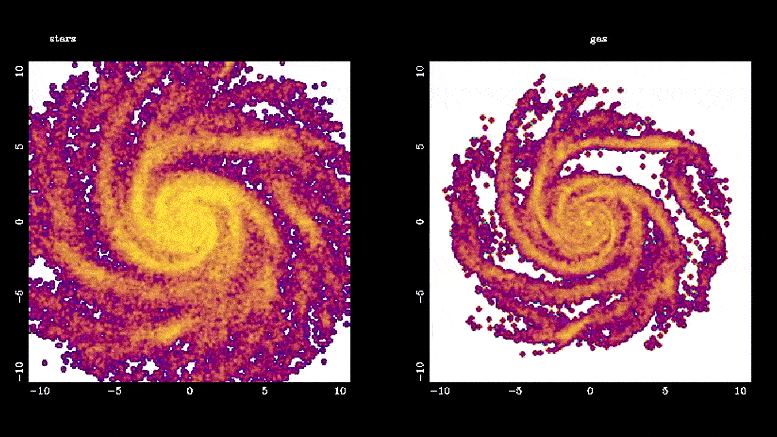
Esta simulação mostra como as hastes estelares (à esquerda) e os fluxos de gás movidos por hastes (à direita) se formam. As barras estelares desempenham um papel importante na evolução galáctica ao canalizar o gás para as regiões centrais da galáxia, onde é rapidamente convertido em novas estrelas, 10 a 100 vezes mais rápido do que no resto da galáxia. As barras também auxiliam indiretamente na formação de buracos negros supermassivos nos centros das galáxias ao direcionar a parte gasosa do caminho. Crédito: Françoise Combes, Observatório de Paris
novas fotos de[{” attribute=””>NASA’s James Webb Space Telescope (JWST) reveal for the first time galaxies with stellar bars — elongated features of stars stretching from the centers of galaxies into their outer disks — at a time when the universe was a mere 25% of its present age. The finding of so-called barred galaxies, similar to our Milky Way, this early in the universe will require astrophysicists to refine their theories of galaxy evolution.
Prior to JWST, images from the Hubble Space Telescope had never detected bars at such young epochs. In a Hubble image, one galaxy, EGS-23205, is little more than a disk-shaped smudge, but in the corresponding JWST image taken this past summer, it’s a beautiful spiral galaxy with a clear stellar bar.
“I took one look at these data, and I said, ‘We are dropping everything else!’” said Shardha Jogee, professor of astronomy at The University of Texas at Austin. “The bars hardly visible in Hubble data just popped out in the JWST image, showing the tremendous power of JWST to see the underlying structure in galaxies,” she said, describing data from the Cosmic Evolution Early Release Science Survey (CEERS), led by UT Austin professor, Steven Finkelstein.

The power of JWST to map galaxies at high resolution and at longer infrared wavelengths than Hubble allows it look through dust and unveil the underlying structure and mass of distant galaxies. This can be seen in these two images of the galaxy EGS23205, seen as it was about 11 billion years ago. In the HST image (left, taken in the near-infrared filter), the galaxy is little more than a disk-shaped smudge obscured by dust and impacted by the glare of young stars, but in the corresponding JWST mid-infrared image (taken this past summer), it’s a beautiful spiral galaxy with a clear stellar bar. Credit: NASA/CEERS/University of Texas at Austin
The team identified another barred galaxy, EGS-24268, also from about 11 billion years ago, which makes two barred galaxies existing farther back in time than any previously discovered.
In an article accepted for publication in The Astrophysical Journal Letters, they highlight these two galaxies and show examples of four other barred galaxies from more than 8 billion years ago.
“For this study, we are looking at a new regime where no one had used this kind of data or done this kind of quantitative analysis before,” said Yuchen “Kay” Guo, a graduate student who led the analysis, “so everything is new. It’s like going into a forest that nobody has ever gone into.”
Bars play an important role in galaxy evolution by funneling gas into the central regions, boosting star formation.
“Bars solve the supply chain problem in galaxies,” Jogee said. “Just like we need to bring raw material from the harbor to inland factories that make new products, a bar powerfully transports gas into the central region where the gas is rapidly converted into new stars at a rate typically 10 to 100 times faster than in the rest of the galaxy.”
Bars also help to grow supermassive black holes in the centers of galaxies by channeling the gas part of the way.
Esta simulação mostra como as hastes estelares (à esquerda) e os fluxos de gás movidos por hastes (à direita) se formam. As barras estelares desempenham um papel importante na evolução galáctica ao canalizar o gás para as regiões centrais da galáxia, onde é rapidamente convertido em novas estrelas, 10 a 100 vezes mais rápido do que no resto da galáxia. As barras também auxiliam indiretamente na formação de buracos negros supermassivos nos centros das galáxias ao direcionar a parte gasosa do caminho. Crédito: Françoise Combes, Observatório de Paris
A descoberta de barras durante essas eras iniciais abalou os cenários de evolução galáctica de várias maneiras.
“Essa detecção precoce das barras significa que os modelos de evolução galáctica agora têm um novo caminho através das barras para acelerar a produção de novas estrelas em idades precoces”, disse Jogee.
E a existência dessas primeiras barras desafia os modelos teóricos porque eles precisam corrigir a física galáctica para prever a abundância correta de barras. A equipe testará diferentes modelos em seus próximos trabalhos.

Uma montagem de imagens do JWST mostra seis exemplos de galáxias barradas, duas das quais representam os maiores tempos de recuperação quantificados e caracterizados até o momento. Os rótulos no canto superior esquerdo de cada número mostram o tempo retrógrado de cada galáxia, que varia de 8,4 a 11 bilhões de anos atrás (Gyr), quando o universo tinha apenas 40% a 20% de sua idade atual. Crédito: NASA/CEERS/Universidade do Texas em Austin
O JWST pode revelar estruturas em galáxias distantes melhor do que o Hubble por dois motivos: primeiro, seu espelho maior oferece maior capacidade de captação de luz, permitindo que ele veja mais longe e com maior resolução. Em segundo lugar, ele pode ver melhor através da poeira porque observa em comprimentos de onda infravermelhos mais longos do que o telescópio Hubble.
Os graduandos Eden Wise e Zilei Chen desempenharam um papel importante na pesquisa, revisando visualmente centenas de galáxias, procurando aquelas que pareciam ter barras, o que ajudou a reduzir a lista a algumas dezenas para que outros pesquisadores pudessem analisá-la com cálculos mais intensivos. . Aproximando.
Referência: “First look at z > 1 Bars in the rest of the near-infrared frame with JWST early CEERS imagery” Por Yuchen Guo, Sharda Joji, Stephen L Finkelstein, Zili Chen, Aiden Weiss, Michaela P Bagley, Guillermo Barrow, Stegen & Witts, Dale D. Kosevski, Jehan S. Kartaltepe, Elizabeth J. McGrath, Henry C. Ferguson, Bahram Mobacher, Mauro Giavalescu, Ray A. Lucas, George A. Zavala, Jennifer M. Lutz, Norman A. Grojean, Mark Huertas-Company, Jesus Vega-Ferrero, Nimish P. Hathi, Pablo Arrabal Haro, Mark Dickinson, Anton M. Koekemoer, Casey Papovich, Nor Pirzkal, LY Aaron Yung, Bren E. Backhaus, Eric F. Bell, Antonello Calabrò, Nikko G. Cleary, Rosemary T. Cogan, MC Cooper, Luca Constantin, Darren Croton, Kelsey Davis, Alexandre de la Vega, Avishai Dekel, Maximilian Franco, Jonathan P. Gardner, Ben W. Holwerda, Taylor A. Hutchison, Viraj Pandya, Pablo G. Perez-Gonzalez, Swara Ravindranath, Caitlin Rose, Jonathan R. Trump, Weichen Wang Aceito, Cartas do Diário Astrofísico.
arXiv: 2210.08658
Outros coautores da Universidade de Austin são Stephen Finkelstein, Michaela Bagley e Maximilian Franco. Dezenas de coautores de outras instituições vêm dos Estados Unidos, Reino Unido, Japão, Espanha, França, Itália, Austrália e Israel.
O financiamento para esta pesquisa foi fornecido em parte pelo Roland K. Blumberg Endowment in Astronomy, pela Heising-Simons Foundation e pela NASA. Este trabalho contou com recursos do Centro de Computação Avançada do Texas, incluindo o Frontera, o supercomputador mais poderoso de uma universidade americana.

“Aficionado por música. Jogador. Praticante de álcool. Leitor profissional. Estudioso da web.”
